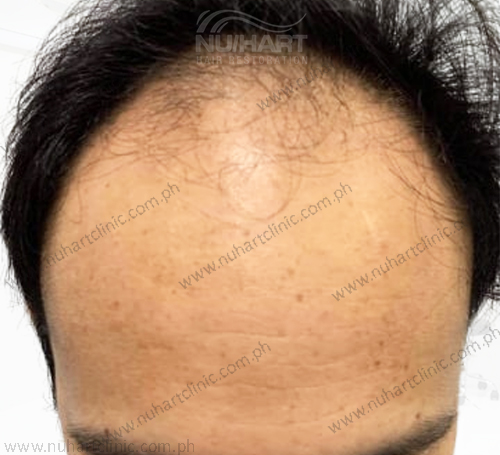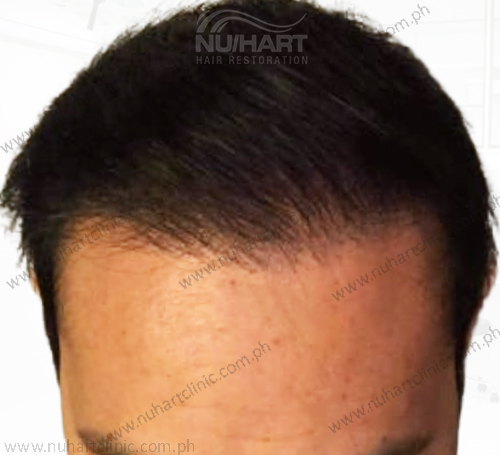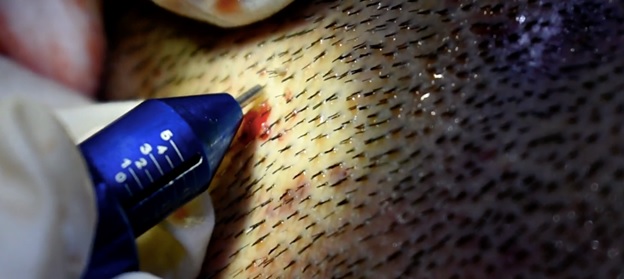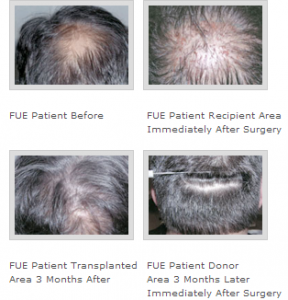FUE Hair Transplant
Proven, Safe & Effective Hair Transplant in the Philippines
A special advancement in the field of hair transplant is the Follicular Unit Extraction (FUE) also known as Follicular Unit Extraction technique. Nu/hart’s FUE technique is a new and safe hair transplant technique done under local anesthesia that utilizes a machine with small punches to individually harvest the follicular grafts directly from the donor site and transplant them to the tiny slits in the recipient area.
FUE Hair Transplant Results After 2 Years (2,000 Grafts)



The specialized punch used in FUE allows the surgeon to remove hair from the skin without causing damage.
This hair transplantation technique is a minimally invasive procedure and therefore the scalp heals faster. A patient can often show no visible signs ten days after surgery.

The FUE hair transplant process offers a procedure with no linear scar, no stitches, no bandages, and faster healing time.
Plus, if multiple sessions are needed, they can be done within weeks of each other. (The time between traditional strip method sessions is usually 6 months to 1 year.) The great thing about FUE is it has a faster healing time and less disruption to your busy schedule. NuHart’s FUE will give you the latest techniques in hair transplantation and the most natural head of hair. Each client needs a full consultation to determine if they are a perfect candidate for this type of hair transplant surgery.
Best Candidates for Follicular Unit Excision (FUE)
- Patients who does not want a linear scar.
- Patients with a limited donor supply.
- Patients with limited scalp elasticity.
- Patients who want to wear their hair exceptionally short.
- Patients who don’t mind closely clipping the donor area hair at the time of the procedure.
Benefits of Follicular Unit Excision (FUE)
- Allows medical team to select each follicular unit and maximize donor harvesting.
- Very low rate of transection.
- Small sessions can be done without shaving the donor area.
- Quicker, more comfortable recovery because there are no stitches.
- Virtually undetectable since there is no linear scar.
THE TRUTH ABOUT HAIR LOSS
Baldness is often blamed on poor circulation to the scalp, vitamin deficiencies, dandruff and even excessive hat wearing. All of these theories have been disproved. It’s also untrue that hair loss can be determined by looking at your maternal grandfather, or that 40-year-old men who haven’t lost their hair will never lose it.
Hair loss is primarily caused by a combination of:
- Aging
- A change in hormones
- A family history of baldness
As a rule, the earlier hair loss begins, the more severe the baldness will become.
Consultation
In your initial consultation, your surgeon will evaluate your hair growth and loss, review your family history of hair loss and find out if you’ve had any previous hair transplant surgery. Your surgeon will also ask you about your lifestyle and discuss your expectations and goals for surgery.
Medical conditions that could cause problems during or after surgery, such as uncontrolled high blood pressure, blood-clotting problems or the tendency to form excessive scars, should also be discussed with your surgeon. Be sure to tell your surgeon if you smoke or are taking any drugs or medications, especially aspirin or other drugs that affect blood clotting.
Therefore, If you decide to have hair transplant surgery, your surgeon will explain anesthesia, the type of facility where the surgery will be performed and the risks and cost involved. Don’t hesitate to ask your doctor any questions.
TALK TO YOUR SURGEONS
Make sure you understand your surgeon’s plan: which procedures will be used and how long each will take. Ask your doctor to give you an idea of what you will look like after the procedure or, if grafts are going to be used, after each stage of treatment in hair restoration.
IS HAIR TRANSPLANT SAFE?
Hair transplant surgery is normally safe when performed by a qualified and experienced board- certified plastic surgeon. Still, individuals vary greatly in their physical reactions and healing abilities, and the outcome is never completely predictable.
Risks and Safety
Around the time new locks start to grow and some people have inflammation or an infection of the hair follicles, called folliculitis. Antibiotics and compresses can relieve the problem. It’s also possible to suddenly lose some of the original hair in the area where you got the new strands, called shock loss. But most of the time, it’s not permanent.
Talk with your doctor about these risks and how much improvement you’re likely to get from the surgery. He can help you decide if it’s a good option for you.
Preparation
You should arrange for someone to drive you home after your surgery. Plan to take it easy for a day or two after the procedure and arrange for assistance if you think you’ll need it.
Recovery
Hair transplant surgery is completed on an outpatient basis, meaning patients are free to return home immediately after their appointment. Following the procedure, the scalp will be reddened, sore and sensitive to the touch. Common side effects include scabbing, itching and numbness that will persist for a couple of weeks.
Hair transplant patients will need to avoid touching their newly-transplanted hair until the grafts heal, about one to two weeks after surgery. Patients can shower the next day but will need to avoid direct water pressure on the scalp and may not shampoo their hair. Brushing and combing will need to be avoided as well so as not to uproot the new hair. Hats can be worn during this time to cover up visible effects of the procedure, so long as they are not overly tight.
TAKE NOTE
Friction and stress on the scalp can have detrimental effects, so patients will need to wait two to three weeks before resuming strenuous activities and exercise. Activities that stretch or pull on the scalp can be particularly harmful to patients who undergo FUT, as too much stress on the incision can cause damage to the sutures.
Hair transplantation surgery is a relatively minor procedure and patients may feel well enough to return to work the very next day. Most patients choose to take at least a few days to one week off from work for immediate side effects to diminish. Hair surrounding the harvest sites will also be shortened and patients may wish to take some time off for hair to grow back.
Concerned About Your Hair Loss Troubles?
Set aside those worries, for now, we at NU/HART Philippines are more than happy to help you deal with this problem. All you have to do is send your inquiries to: info@nuhartclinic.com.ph
Subscribe To Our Newsletter
Stay in touch with us to get latest news and special offers.
Why NU/HART?
These numbers speak for themselves!